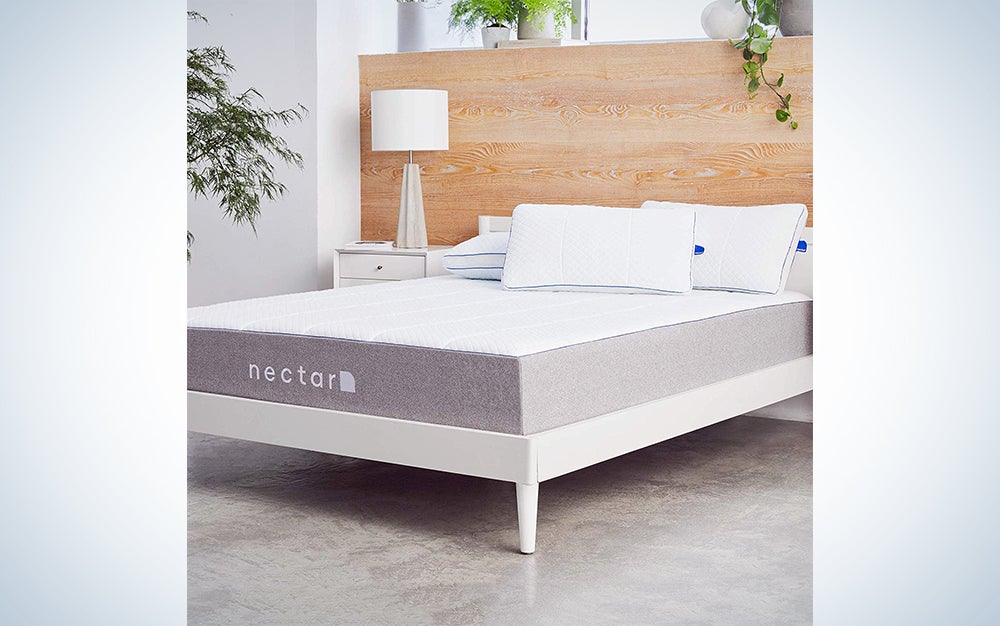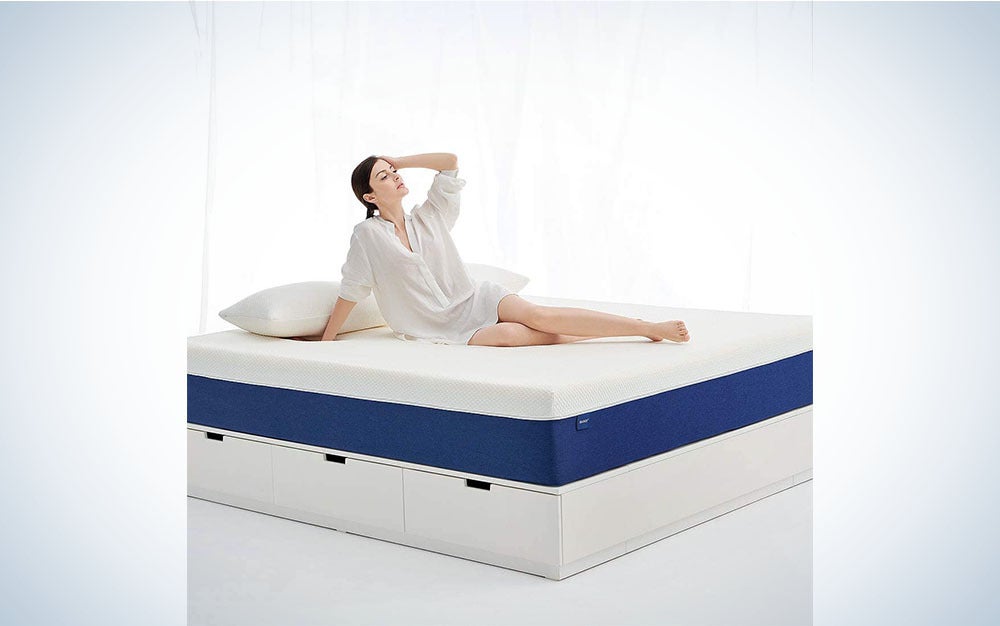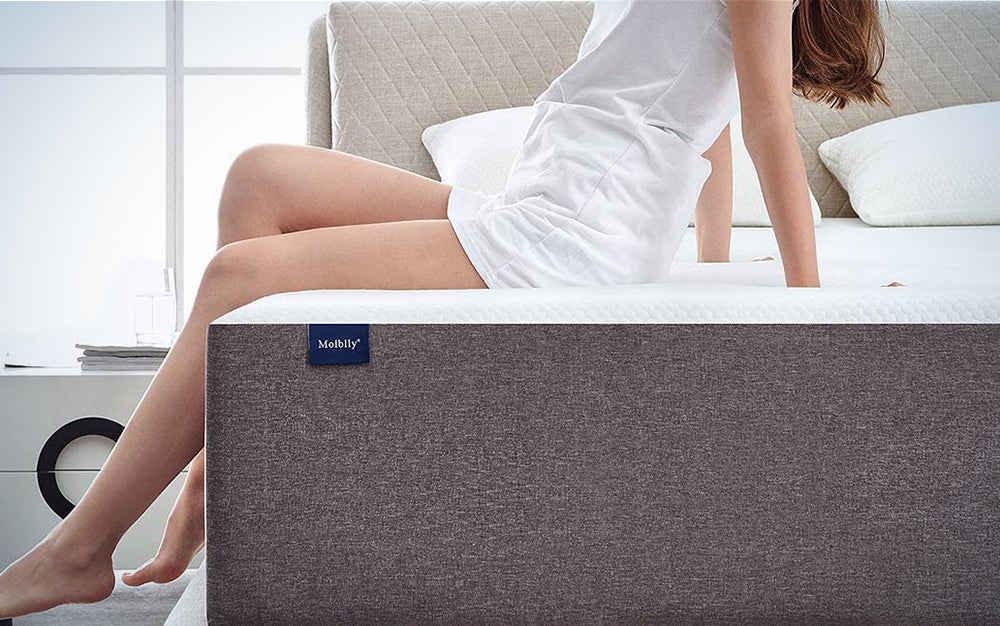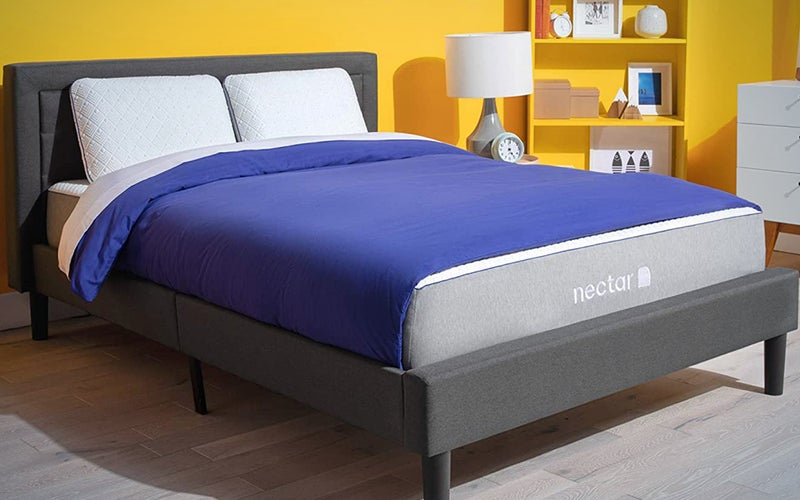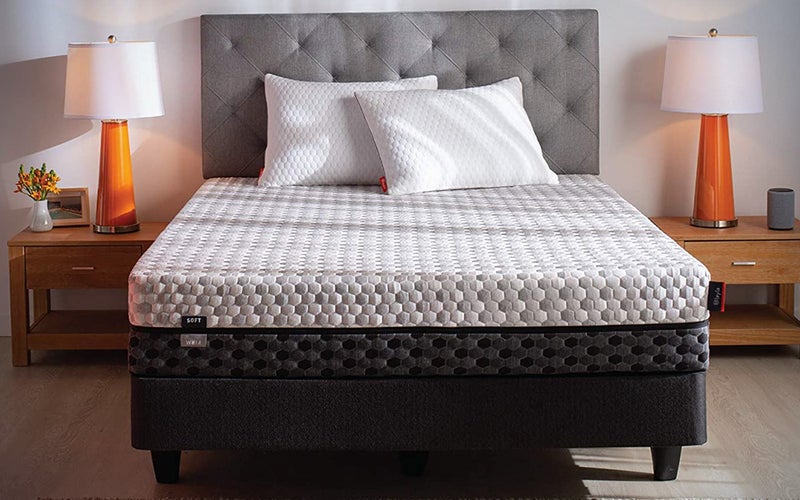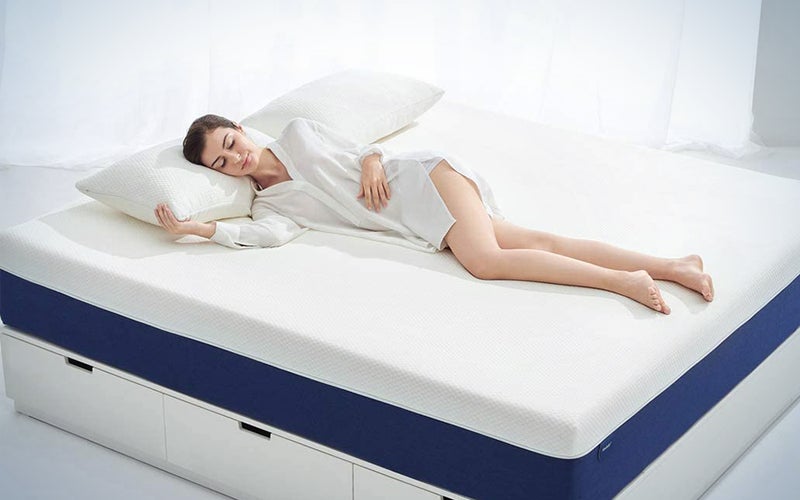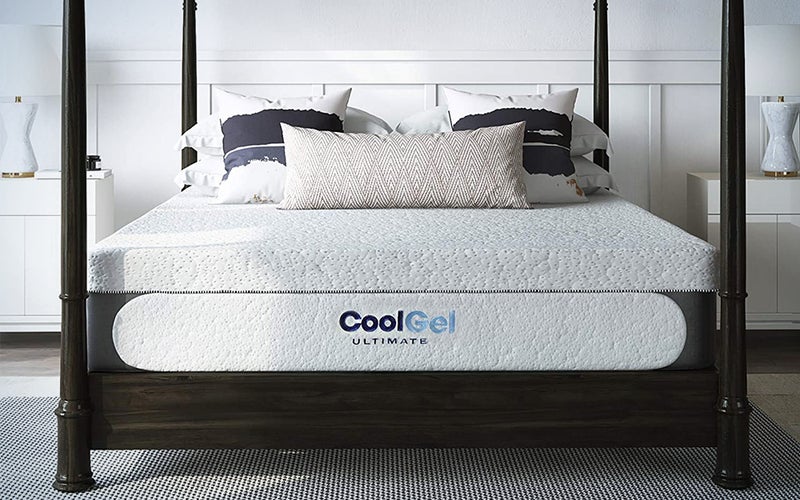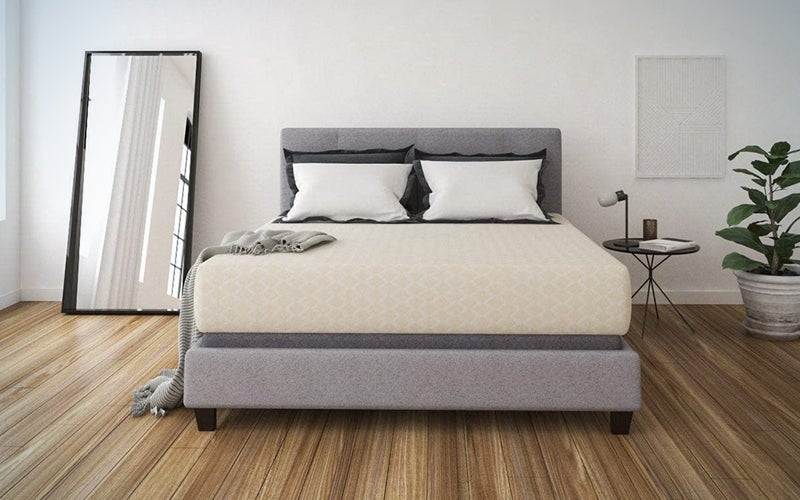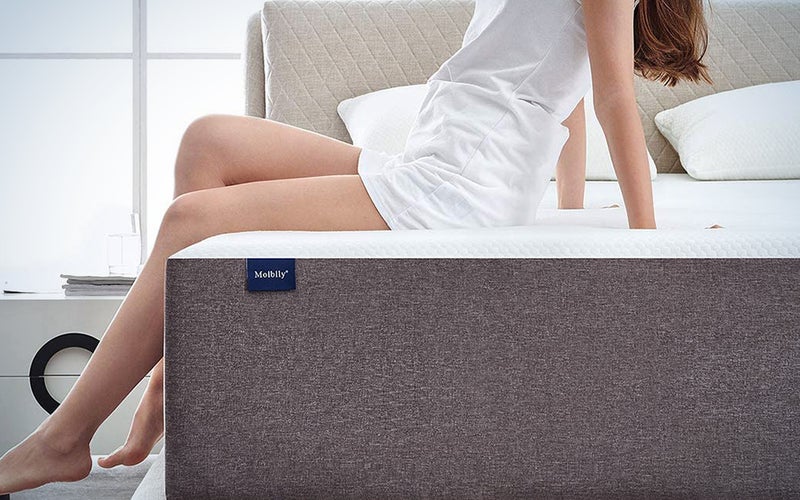We may earn revenue from the products available on this page and participate in affiliate programs. Learn more ›
Sleep is rejuvenating and so important for our health. Yet it’s so hard for so many of us to get enough quality shut-eye. The best memory foam mattress will help you fall asleep and stay that way.
There are as many different types of mattresses as there are sleeping positions — cotton, wool, latex, silk, cashmere, and a series of fabric-encased coils, to airbeds, futons, and waterbeds. With the best memory foam mattress, you can reap a range of benefits other styles won’t necessarily provide all at once. This piece of bedroom furniture will mold to your body weight and quickly return to its original shape when you get up, which means less time spent shuffling positions while trying to get comfortable every time you get into bed. The best memory foam mattress will also adjust to your body temperature, offer support to aching body parts, provide allergy relief, and stop you from waking up your partner with every move you make.
So it’s a good move to find the best memory foam mattress for yourself, but also for the person who sleeps beside you every night.
- Best overall: Nectar King Gel Memory Foam Mattress
- Best with density options: Layla Sleep Copper Infused Memory Foam Mattress
- Best thick: Molblly 14 inch Gel Memory Foam
- Most size choices: Classic Brands Cool Gel Memory Foam 14-Inch
- Best for easy upkeep: Ashley Chime 12 Inch Medium Firm Memory Foam Mattress
- Best budget: Molblly 12 In. Memory Foam Mattress In A Box
The best memory foam mattresses: Reviews & Recommendations
Best overall: Nectar King Gel Memory Foam Mattress
Amazon
Five layers maximize comfort in this Nectar King Gel Memory Foam Mattress. The top layer is a cooling Tencel cover with fibers that wick moisture more effectively than standard cotton. The next layer distributes your weight. A third layer provides support, while a fourth base layer reinforces that support. Underneath them all, a cover keeps the mattress from slipping on the frame.
Best with density options: Layla Sleep Copper Infused Memory Foam Mattress
Amazon
Copper on the inside keeps things cool, and if the medium-soft side doesn’t suit your sleeping needs, you can flip it over for more firmness. The Layla memory foam mattress works with any kind of foundation. Each order arrives with two memory foam pillows, a microfiber sheet set, and a mattress protector.
Best thick: Molblly 14 inch Gel Memory Foam
Amazon
This gel memory foam mattress has 14 inches, which are divided into three inches of gel memory foam, two inches of comfort foam, 1.5 inches of soft pressure relief foam, and eight inches of high-density base support foam. A hypoallergenic cover protects the mattress while keeping sleepers dry and comfortable. After unpacking and unrolling it, you should allow it to sit for 72 while it expands into its regular shape and all manufacturing odors dissipate.
Most size choices: Classic Brands Cool Gel Memory Foam 14-Inch
Amazon
This cooling memory foam mattress comes packed with all the attractive features and enhancements one should expect from the best memory foam mattress, including a stretch knit fabric cover. Included with the purchase are two shredded memory foam pillows that will ensure your head is as comfortable as your body while you’re sleeping. Just unwrap, let it decompress to its normal mattress shape, and be sleeping in total body comfort in just a few hours.
Best for easy upkeep: Ashley Chime 12 Inch Medium Firm Memory Foam Mattress
Amazon
To ensure a long and effective life for this 12-inch memory foam mattress, use a thin mattress pad that allows it to breathe. A quilted pad may trap heat and change the feel of the mattress. Dry cleaning materials could damage the upholstery and affect the comfort level, and aside from dabbing it with mild soap and water and letting it air dry completely to remove stains, vacuuming is the only recommended form of cleaning. If you have small kids, keep them from jumping on the mattress as that can break down the materials.
Best budget: Molblly 12 In. Memory Foam Mattress In A Box
Amazon
This budget-friendly mattress adapts and conforms to your body for optimal pressure relief, and the specialized foams reduce bed motion so your sleep—and your partner’s—is undisturbed. Also includes a soft, washable hypoallergenic cover layer
Best memory foam mattress brands to know
Ultimately, what will determine if a memory foam mattress is right for you will be how your body feels when you’re sleeping on it. Some brands may have a reputation for offering better quality, but that doesn’t mean the foam mattresses they produce will provide a higher level of comfort every time you lay down to sleep. But every testing phase must begin somewhere, and several brands consistently receive high marks from people who buy them.
Layla
Its dual-sided design means you can get medium-soft comfort on one side or flip it over and get a firm foundation on the other side. The company infuses their mattress material with copper, which fights bacteria, viruses, fungi, and mold while also keeping you cooler as you sleep. Layla was founded on April Fool’s Day in 2016, but the benefits of their mattresses are no joke.
Loom & Leaf
Launched in 2014 by the New York-based Saavta, Loom & Leaf memory foam mattresses feature temperature regulation and a soft organic cotton cover and Spinal-Zone Gel to improve spinal alignment. They also have additional memory foam layers to support heavier side sleepers who weigh over 230 pounds.
Nectar
This brand’s mattresses feel higher-end, but they come with a surprisingly affordable price tag. They’re constructed using four layers of foam that work in tandem to provide cooling, pressure relief, support, and motion isolation. Founded in 2016, it’s quickly risen through the ranks of the best memory foam mattresses.
What to consider when buying the best memory foam mattresses
Before setting out to buy the best memory foam mattress your money can buy, there are several factors to consider: type of memory foam (there are a few), thickness and density, what size you want, and how much maintenance it will need. We’ll walk you through careful consideration of each of these factors to help you pick a mattress you could be sleeping on—blissfully—for years to come.
In case you’ve decided to give your mattress one last chance, consider a memory foam mattress topper instead. It will give you the cushion of a memory foam mattress without replacing your entire sleep setup.
What type of memory foam is best for you?
Memory foam is made of polyurethane or latex, combined with certain chemicals to improve the viscosity and elasticity. Viscosity refers to the ability of the material to remain in place when pressure is applied. Elasticity refers to the ability of the material to stretch, change its shape and return to its original form. If you suffer from chronic pain due to conditions like arthritis and fibromyalgia, the best memory foam mattress will feel like a godsend. You may also rejoice if you struggle to find a suitable sleeping position or an ideal level of firmness: Side sleepers will get more shoulder and hip support, back sleepers will get all-important lumbar support, and stomach sleepers will get some protection against their lower backs arching too much.
There are three different types of memory foam, and each one comes with specific advantages. Traditional memory foam gives your body support by conforming to your shape and weight. It minimizes pressure points and also improves circulation. Gel memory foam is similar to the gel material used in some shoe inserts in order to reduce pressure. It creates a cool sleeping surface and helps regulate body temperature. The open-cell foam keeps you cool through pockets that allow airflow. The holes mean the mattress is less dense, though, and might not last as long.
Latex foam isn’t technically a “memory foam,” but it’s often lumped into this category. Although it doesn’t conform to your body shape in the same way traditional memory foams do, it’s so plush and comfortable that it almost doesn’t matter. The major benefit is that it comes from natural sources and is antimicrobial and hypoallergenic. Just be sure to skip over this one if you are allergic to latex.
Here’s what you need to know about memory foam mattress density
Memory foam comes in three different densities: high, medium, and low—and they’re measured by the weight of the foam. High-density foam weighs between 6 and 10 pounds per cubic foot. It’s typically good for circulation and tends to have a longer lifespan. The high-density foam may take longer to break-in, but it offers excellent support for folks with back pain. Medium-density foam ranges from four to five pounds per cubic foot and helps to isolate your body movements during the night so sleeping partners disturb each other less often. Low-density memory foam weighs three pounds per cubic foot or less. It’s easier to break in but it’s not great for stomach sleepers, who typically need a firmer surface. It’s plush, and you’ll sink into it more quickly than medium- and high-density foam.
The best memory foam mattresses will often have layers of varying densities, with a high-density base for greater longevity and optimal assistance with improving your circulation, and a lower-density layer on top for cushion and comfort.
How thick should your mattress be?
Memory foam mattresses typically run anywhere from six inches up to 16 or more. The thicker it is, the cushier it will feel. Thicker is also typically better for higher-weight sleepers. A slim-profile foam mattress less than 8 inches thick is going to work best for children and petite folks who weigh less than average. Thicker mattresses are typically softer than thinner ones, thanks to additional levels of foam, and provide more support for heavier bodies
What size mattress do you want?
Memory foam mattresses come in all the standard mattress sizes, which makes them easy to pair with whatever bed platform or box spring you already have. As a general rule, you want to have at least 30 inches on each side of the room beyond the bed/mattress combo to allow easy and free movement—so get out your measuring tape. A twin size mattress measures 39 inches wide by 75 inches long and is meant to sleep one; a twin XL is suitable for taller singles at 39″ x 80″. Double, or full size, mattresses are 54″ by 75″.
Couples typically do best in a queen-size bed or larger (unless they’re both quite petite and are big cuddlers!). Queen mattresses clock in at 60 inches wide by 80 inches long. King size mattresses are 76″ X 80″ and California Kings are 72″ X 84″.
What kind of maintenance will your mattress need?
Think of your new mattress as an investment. The best ones aren’t cheap, but they can last you up to 10 to 15 years, with the right maintenance.
The first thing you’ll want to do is buy a protective mattress pad to help keep it clean—staining can void mattress warranties. Next, you’ll want to run over the mattress with a handheld vacuum or upholstery attachment every time you change the sheets and get rid of dead skin and dust mites.fOther tips for enhancing the lifespan include rotating it every four to six months so it wears evenly, keeping it in a sunlit and well-ventilated room to prevent odor from creeping in, and washing your bedding and mattress cover weekly.
How much do you have to spend?
Premium queen-size memory foam beds can cost as much as $5,000. But if you, like us, don’t think sleeping well should cost that much, you can get a great one in the $1,000 price range. For limited budgets, there are even some decent memory foam picks out there for under $300. Just know that the lower-end wallet-friendly options won’t have as much cushion, and won’t last as long, as the mid-range or premium ones will.
FAQs
Q: What is the best memory foam mattress?
Though you should take into account your unique sleeping preferences when selecting a memory foam mattress, critics seem to have a few top picks that suit most people. The Nectar King Gel Memory Foam Mattress and Layla Sleep Copper Infused Memory Foam Mattress are sure to keep you supported and comfortable all night long.
Q: How long does a memory foam mattress last?
Memory foam mattresses last just as long as any other type—which is to say about eight to ten years. Proper care and cleaning of your mattress will keep it fresh and help it last as long as possible.
Q: How long does it take for a memory foam mattress to inflate?
While inflation might vary from mattress to mattress, the best recommended time zone to allow for complete inflation is generally from 24 to 48 hours. If your pick was completely compressed, it might take the full two days to fill and be ready for sleeping.
Final thoughts on best memory foam mattresses
- Best overall: Nectar King Gel Memory Foam Mattress
- Best with density options: Layla Sleep Copper Infused Memory Foam Mattress
- Best thick: Molblly 14 inch Gel Memory Foam
- Most size choices: Classic Brands Cool Gel Memory Foam 14-Inch
- Best for easy upkeep: Ashley Chime 12 Inch Medium Firm Memory Foam Mattress
- Best budget: Molblly 12 In. Memory Foam Mattress In A Box
The best mattress is an essential part of your bedroom furniture set. If you’ve decided to ditch a traditional springs for memory foam, you’ll probably pay a little bit more upfront, but the added comfort, cushion, and support will be worth it. The best memory foam mattress for you is one that will fit in your bedroom, provide the support you need, and, perhaps most importantly, fit your budget. Good luck on your shopping expedition—and if you get tired of doing the legwork, come on back here and go with one of our picks.
Why trust us
Popular Science started writing about technology more than 150 years ago. There was no such thing as “gadget writing” when we published our first issue in 1872, but if there was, our mission to demystify the world of innovation for everyday readers means we would have been all over it. Here in the present, PopSci is fully committed to helping readers navigate the increasingly intimidating array of devices on the market right now.
Our writers and editors have combined decades of experience covering and reviewing consumer electronics. We each have our own obsessive specialties—from high-end audio to video games to cameras and beyond—but when we’re reviewing devices outside of our immediate wheelhouses, we do our best to seek out trustworthy voices and opinions to help guide people to the very best recommendations. We know we don’t know everything, but we’re excited to live through the analysis paralysis that internet shopping can spur so readers don’t have to.

